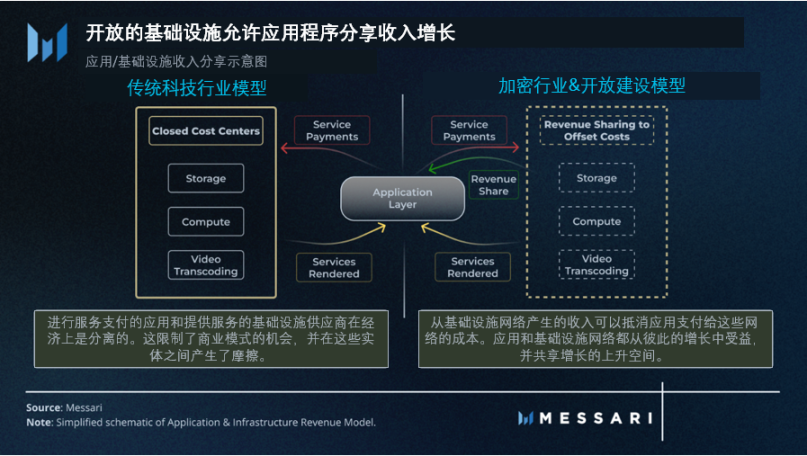Messari: Exploring Native Crypto Business Models
Written by: Seth Bloomberg
Original Title: 《The Search for Crypto-Native Business Models》
Compiled by: YYT, Huzi Guanbi
Key Insights
- Unlike Web2 platforms that have successfully developed monetization strategies, crypto applications are still seeking to combine shared computing and user layers into sustainable business models.
- The shift towards crypto-native IP is changing traditional centralized IP creation and distribution models. IP markets like Storyverse provide a new coordination mechanism for IP holders, content creators, and consumers. In these markets, closely linking IP distribution with revenue sharing and attribution is a key limiting factor.
- Crypto economic models like DePIN are enabling a symbiotic relationship between applications and technological infrastructure. This opens up new revenue streams and flexible business models for applications, but it also requires significant expertise and capital investment in related fields.
- Uniswap V4 is transitioning from standalone applications to platform protocols by leveraging hook models. Hook models or platform models create strong network effects. As platform network effects have proven to be highly competitive and defensible, more applications may strive to position themselves similarly.
Strangely, even when products are widely used, companies do not necessarily capture significant revenue from their products. Instead, the value they capture largely depends on the defensibility of the product against competitors and the pricing model, which is the business model.
Email is a widely used product in Web1, but it is a typical example of failing to capture value. SMTP (Simple Mail Transfer Protocol), as an underlying open and permissionless protocol, is the standard protocol relied upon by email providers. However, the openness of SMTP has, to some extent, acted as a double-edged sword, leading companies to build fiercely competitive products with little ability to charge users.
The open-source nature of crypto products and protocols introduces similar business model challenges. However, the shared computing and user layers of crypto have advantages over Web1 protocols. In many ways, this structure resembles the dominant platform models in Web2, which concentrate demand and supply on a single closed platform (e.g., social media platforms like Twitter and TikTok). Meanwhile, crypto applications are still searching for a way to combine similar elements to create a sustainable business model.
From DeFi applications to consumer-focused, IP-centric applications, there have been many experiments exploring sustainable business models in an open-source environment. Many of these involve building IP creation and distribution mechanisms, leveraging open infrastructure networks, and developing platform protocols:
- IP Distribution Mechanisms: Historically, IP distribution has typically been adopted in film, gaming, or other media productions. Companies fill their media with their own IP, such as Disney movies filled with Disney characters. The key to this model lies in the centralized nature of the company, where creative talent and value accumulation typically flow to the company. In contrast, crypto is touted as a novel means of coordination and distribution. From the perspective of IP creation and distribution, IP markets can serve as this coordination point, allowing IP holders (e.g., NFT holders), creators, and consumers to collaborate with each other. Compared to traditional centralized approaches, the crypto method creates new primitives for each participant to engage and explore together.
- Open Infrastructure Networks: Decentralized physical infrastructure networks (DePIN) can initiate hardware-based infrastructure, such as storage and computing networks (e.g., AWS in the Web2 world). The DePIN model aims not only to solve the chicken-and-egg problem faced by these networks but also creates revenue-sharing opportunities for applications utilizing the infrastructure. Permissionless access allows applications not only to functionally use the infrastructure but also to participate in the economic activities of the network.
- Platform Protocols: While almost all major applications in Web2 are some form of platform, the recent launch of Uniswap V4 provides an example of how a standalone crypto application can transition into a platform protocol. By creating conditions that allow core assets of the protocol to be accessed without barriers and without additional fees, Uniswap V4 has gained strong network effects and a defensible position in the market.
Each model is worth exploring and experimenting with; however, they often come with trade-offs.
IP Creation and Distribution Mechanisms
Traditional IP creation and distribution methods rely on the creativity and scale of a centralized entity. Typically, a company is responsible for hiring creative talent to develop and produce IP, and then subsequently marketing and distributing it. This approach is inherently expensive, resulting in high barriers to entry and slow consumer feedback. As the content and IP created in the form of NFTs continue to grow, the industry requires new business models for creation and distribution.
Creating and Distributing IP
NFTs are crypto-native IP, and the projects behind them adopt a business model centered around airdrops, hype, and continuous NFT collection series. For example, Azuki recently launched the Elementals series in addition to its original Azuki collection. While new releases can significantly increase the project's financial reserves, they also risk diluting existing holders by creating more NFTs. Additionally, the delivery time for long-anticipated mints is often too long. The longer the wait, the greater the likelihood that the community perceives the project's delivery as insufficient, which can lead to a decrease in brand trust.
Nouns takes a unique approach to generate revenue while managing community attention and expectations. Nounish DAOs (i.e., DAOs that follow the general model established by Nouns) regularly and continuously auction new NFTs. The minting revenue accumulates in a treasury managed by NFT holders. This model works well for Nouns, which now has over $50 million in its treasury and has allocated nearly 36,000 ETH to fund projects approved by management.
Due to the flexible funding structure of this model, it may be best suited for open, generalized DAOs, but reaching consensus on indicators of a project's success can be challenging. Furthermore, once the initial NFTs are minted, there is no actual entity to create and distribute secondary creations. To encourage widespread experimentation, projects will need to maintain substantial cash flow to supplement their treasury.
IP Markets
The existence of IP markets is to connect parties traditionally linked by centralized companies. These new, crypto-native IP markets focus on three core stakeholders in the value chain: IP holders (e.g., a CryptoPunk holder), creative talent, and consumers. Creative talent can utilize the assets of IP holders to create characters in games or craft animated stories. The ultimate consumers may be passive participants or provide some initial or ongoing feedback during the creation process.

The IP market of Storyverse allows content creators to use NFT IP, such as Bored Apes, in the stories they create on the application. The Spores protocol functions similarly but focuses more on music creation. Anyone can remix songs uploaded to the application. The goal is to enable creators to easily and simply create content while allowing consumers to mint and collect these works. At the end of 2022, Nike announced its .Swoosh platform. The "YourForce1" challenge gives individual creators the opportunity to propose concept designs for shoes and potentially collaborate with Nike designers (while winning cash rewards).
While the .Swoosh model resembles a top-down approach, its crypto-native version allows for greater flexibility between IPs and can utilize on-chain revenue distribution mechanisms like 0xSplits and Superfluid.
A major challenge for emerging IP markets is distribution. Nike, as a well-known brand with a large user base, can leverage these advantages to distribute and sell IP. New markets not only need to attract IP holders but also face the challenge of developing solid distribution channels to support these innovative consumer experiences. IP markets also need to consider combining revenue payments with distribution. When IP is distributed across different channels, creators need a clear and executable payment mechanism.
However, over a longer time frame, the ownership attributes associated with crypto-native IP should be able to align incentives for each participant. If certain NFTs or IP can attract a sufficient audience, their influence should draw holders and talented creators to develop new content around them.
Application and Open Infrastructure Revenue Sharing
Traditional tech stacks consist of various layers of components, but they are produced by different entities. This stack is financially tied together through contracts, with the companies behind it fiercely competing to gain an edge in the market. This limits the available business models. CloudFlare and its applications are an example of this dynamic.
Companies use CloudFlare as a protected content delivery network. CloudFlare's role is to charge service fees to applications. However, CloudFlare and the applications using it are essentially isolated from each other. These companies have no way to give back to CloudFlare or participate in the potential rise of network revenue, creating friction between applications and infrastructure.
However, cryptocurrencies and DePIN models encourage entities to participate in infrastructure networks like CloudFlare. This provides a mechanism to coordinate the tech layer, opening the infrastructure network to participants on both the supply and demand sides. Applications can achieve more flexible business models as they can profit from their contributions to the infrastructure network.

Xeeno & Livepeer
To illustrate this model, let’s look at Livepeer and Xeeno. Livepeer is a decentralized transcoding service that connects applications needing video transcoding services with nodes (coordinators) executing the transcoding. Xeeno is a Web3 streaming platform. Since Xeeno must provide streaming capabilities for content creators, it relies on Livepeer as the core infrastructure of the platform.
To complete the application/infrastructure revenue-sharing loop, Xeeno operates a Livepeer coordinator, allowing it to earn fees paid by Livepeer users as well as earn inflation rewards in LPT. In March 2023, Xeeno announced its creator revenue-sharing model. The platform plans to share a portion of the Livepeer fees/rewards it earns with content creators. This model creates a symbiotic relationship between the application and the infrastructure supporting it, uniquely enabled by crypto economic models.
Generalization of Symbiotic Application and Infrastructure Models
The approach demonstrated by Xeeno and Livepeer is likely extendable to other application/infrastructure relationships. Many social applications allow content creators and developers to store their content on Arweave. In addition to the provenance benefits Arweave provides to creators, applications utilizing Arweave may further advance their own Arweave miners. If the Arweave network grows and demand increases, applications with their own Arweave miners will also economically benefit from the increased usage of the storage network.
Additionally, with the growing interest in account abstraction, smart contract account providers should benefit from increased adoption. Account abstraction typically drives users to transition from externally owned accounts (e.g., standard MetaMask accounts) to smart contract accounts provided by Argent or Safe. As more users shift to using smart contract accounts, applications will naturally turn to integrating these accounts to meet user needs, thereby increasing adoption.

While smart contract accounts offer many benefits to users, they also require specialized infrastructure services, such as bundlers and paymasters, within the ERC-4337 architecture. The role of bundlers is similar to that of traditional block builders, so they theoretically generate revenue by pushing their transactions on-chain through fees paid by users. Paymasters allow users to pay transaction fees with non-native gas tokens, such as USDC. For this conversion service, paymasters can charge users additional fees.
Smart contract account providers may build their own bundlers or paymasters and integrate them with their wallets. They can then allow other wallet providers to utilize these services. As bundlers and paymasters generate revenue, wallet providers can return a portion of that revenue to users.
In practice, many of these infrastructure services require a high degree of expertise and domain knowledge, as well as various levels of initial and ongoing capital costs. For example, block building has gradually become a highly competitive market, making it difficult for ordinary bundlers to fund an entire business this way, but they can use revenue for user loyalty or rewards. In the Livepeer model, applications like Xeeno may wish to launch more coordinators. Naturally, this approach will include upfront costs for deploying new nodes, as well as operational costs for maintaining or upgrading those nodes.
However, these models are particularly enabled by the open and permissionless nature of infrastructure networks in crypto. As applications continue to integrate with these networks, these revenue-sharing models become increasingly attractive for both the infrastructure networks and the applications themselves.
Hooks & Platform Protocols
The reason platform business models became dominant in Web2 is due to their ability to create strong network effects. The closed-source, proprietary nature of these platforms contrasts with the permissionless, open-source model of Web3. In other words, strategies from the old Web2 world do not translate clearly into Web3. Applications can be replicated, and due to the openness of the data layer, the switching costs for users are significantly reduced.
In Web3, the underlying blockchain is viewed as the primary platform, rather than the application protocols built on top of it. The ability of application protocols to maintain strong, defensible network effects during scaling has historically been elusive. The Uniswap V4 model and its introduction of hook functionality provide insights into how applications can transition from standalone applications to true platform protocols.

Uniswap V4 -- Platform Protocol
Hooks are smart contracts that allow external developers to build applications that access the underlying assets or services provided by the platform. New applications built on Uniswap will direct new demand towards asset providers (LPs), attracting new LPs into the market and creating strong network effects.
In Uniswap V4, Hooks enable Uniswap to sell access to the underlying assets (liquidity) rather than selling the assets themselves directly. Therefore, Uniswap can effectively profit from applications built on its platform rather than taxing LPs. By shifting revenue generation towards external applications rather than taxing core service providers (LPs), Uniswap creates a more defensible position.
Generalization of Platform Protocols
The hooks model can be generalized and applied to other industries and protocols beyond DeFi. For example, social protocols like Lens have modules that effectively simulate hooks. These modules allow Lens to let users join the network for free, similar to the effect Hooks provide for Uniswap. Thanks to these capabilities, developers can leverage the underlying social graph provided by Lens and its modules to create their own applications to acquire users on the Lens social graph. Modules like the "fee collection" module provide builders and creators with pre-built monetization methods for their use as needed.
Wallet infrastructure provider Safe and its Safe{Wallet} (formerly known as Gnosis Safe) are also working to become a platform protocol. On the Ethereum mainnet alone, nearly 150,000 Safe{Wallets} have been deployed by retail users and DAOs. This massive user base presents an ideal distribution channel for wallet developers. Safe also uses smart contract modules to provide external functionalities. These modules allow the Safe team and third parties to potentially profit and enhance the core Safe{Wallet} product. Just like in the case of Uniswap V4 and its hooks, there are security concerns for Safe, as there is no clear way to warn users which modules may be malicious.
Path to Becoming a Platform Protocol
Each protocol must follow a unique path to achieve the desired platform model. For instance, Uniswap and Safe built their initial applications on top of their core protocols. This allowed them to attempt to capture demand while simultaneously building and strengthening the supply side of the protocol. Since Safe is more akin to a stateless protocol, its success in capturing demand may lie in its ability to create value-added services within applications. On the other hand, Lens has so far avoided developing applications, instead incentivizing external developers to build on top of the core protocol.
Lens's path allows it to maintain trusted neutrality, which has become increasingly important—especially for social media—due to the platformization of polarized figures on social networks. This neutrality should attract more developers to build applications on the Lens network. However, the apparent lack of flagship products to drive demand for the network may slow its growth.
In Conclusion
To continue driving the development of the ecosystem, new business models may emerge around the creation and distribution of IP, the economics of utilizing open infrastructure networks, and the creation of platform protocols.
In particular, models involving IP markets and the symbiotic relationship between applications and their infrastructure networks are new innovations enabled by crypto networks. While their inherent novelty creates a vast design space to explore, these models face constraints in developing robust distribution channels and navigating intense, specialized competition in emerging markets.
Among the models discussed, platform protocols have the clearest path to achieving a defensible market position with minimal downside risk. Nonetheless, these emerging models are likely to see widespread innovation in both DeFi and consumer sectors.












